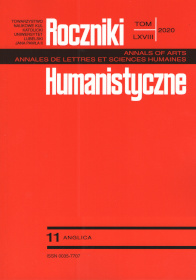The Concept of the Edge in the Plays of Marina Carr
Abstrakt
Pojęcie krawędzi w sztukach Mariny Carr
Kobiety w sztukach Mariny Carr zawsze są na krawędzi. Mai cierpi z powodu braku indywidualności i próbuje odrzucić ograniczenia narzucone przez rodzinę, Portia walczy o prawo do bycia matką która nie kocha swoich dzieci, Hester nie potrafi żyć poza trzęsawiskiem, które ją zabija, a Catherine próbuje żyć we śnie. Krawędź w sztukach Mariny Carr można zdefiniować jako przestrzeń umysłu, przestrzeń oporu w której bohaterki próbują zamieszkać. Krawędź oznacza margines na którym kobiety odnajdują własną przestrzeń. W późniejszych sztukach Mariny Carr mitologiczne, wiejskie krajobrazy ustępują miejsca współczesności. Przestrzenie miejskich napięć i konfliktów tworzą krawędzie, które są bardziej widoczne w przestrzeni dramatu, a transformacje dokonują się poprzez prowokacyjne dialogi i zachowania, wskazujące na nowe pojęcie krawędzi na której kobiety nadal poszukują swojego miejsca.
Bibliografia
Carr, Marina. “Marina Carr in Conversation with Melissa Sihra.” Theatre Talk: Voices of Irish Theatre Practitioners, edited by Lilian Chambers et al., Carysfort Press, 2001, pp. 55–64.
Carr, Marina. Marble. The Gallery Press, 2009.
Carr, Marina. Marina Carr: Plays 1. Low in the Dark, The Mai, Portia Coughlan, By the Bog of Cats... Faber and Faber, 1999.
Foley, Anthony J., and Stephen Lalor, editors. Gill & Macmillan Annotated Constitution of Ireland. Gill and Macmillan, 1995.
Fouéré, Olwen. “Journeys in Performance.” The Theatre of Marina Carr, edited by Cathy Leeney and Anna McMullan, Carysfort Press, 2003, pp. 160–72.
Friel, Judy, and Sanford Sternlicht, editors. New Plays from the Abbey Theatre: Volume Two 1996–1998. New York, Syracuse UP, 2001.
Gardner, Lyn. “Death Becomes Her.” The Guardian, 29 Nov. 2004, www.theguardian.com/stage/ 2004/nov/29/theatre. Accessed 22 July 2020.
Heaney, Seamus. Finders Keepers: Selected Prose 1971–2001. Farrer Straus, 2002.
hooks, bell. “Choosing the Margin as a Place of Radical Openness.” Gender Space Architecture, edited by Jane Rendell et al., Routledge, 2000, pp. 203–9.
hooks, bell. Feminist Theory: From Margin to Center. South End Press, 2000.
Lefebvre, Henri. The Production of Space. Blackwell Publishing, 1984.
Leeney, Cathy. “Marina Carr: Violence and Destruction: Language, Space and Landscape.” A Companion to Modern British and Irish Drama 1880–2005, edited by Mary Luckhurst, Blackwell Publishing, 2008, pp. 509–18.
Lojek, Helen. The Spaces of Irish Drama. Stage and Place in Contemporary Plays. Palgrave Macmillan, 2011.
Massey, Doreen. Space, Place and Gender. Minneapolis, U of Minnesota P, 1994.
Novillo-Corvalán, Patricia. “The Theatre of Marina Carr: A Latin American Reading, Interview, and Translation.” Irish Migration Studies in Latin America, vol. 7, no. 2, 2009, pp. 145–55.
O’Toole, Fintan. “Figures on a Dark Landscape.” The Irish Times, 2 Apr. 1996, p. 10.
Roche, Anthony. “Woman on the Threshold: J. M. Synge’s The Shadow of the Glen, Teresa Deevy’s Katie Roche, and Marina Carr’s The Mai.” The Theatre of Marina Carr, edited by Cathy Leeney and Anna McMullan, Carysfort Press, 2003, pp. 17–43.
Sihra, Melissa. “Nature Noble or Ignoble: Woman, Family and Home in the Theatre of Marina Carr.” Hungarian Journal of English and American Studies (HJEAS), vol. 11, no. 2, Fall 2005, pp. 133–47.
Sihra, Melissa, editor. Women in Irish Drama: A Century of Authorship and Representation. Palgrave Macmillan, 2007.
Copyright (c) 2020 Roczniki Humanistyczne

Utwór dostępny jest na licencji Creative Commons Uznanie autorstwa – Użycie niekomercyjne – Bez utworów zależnych 4.0 Międzynarodowe.





